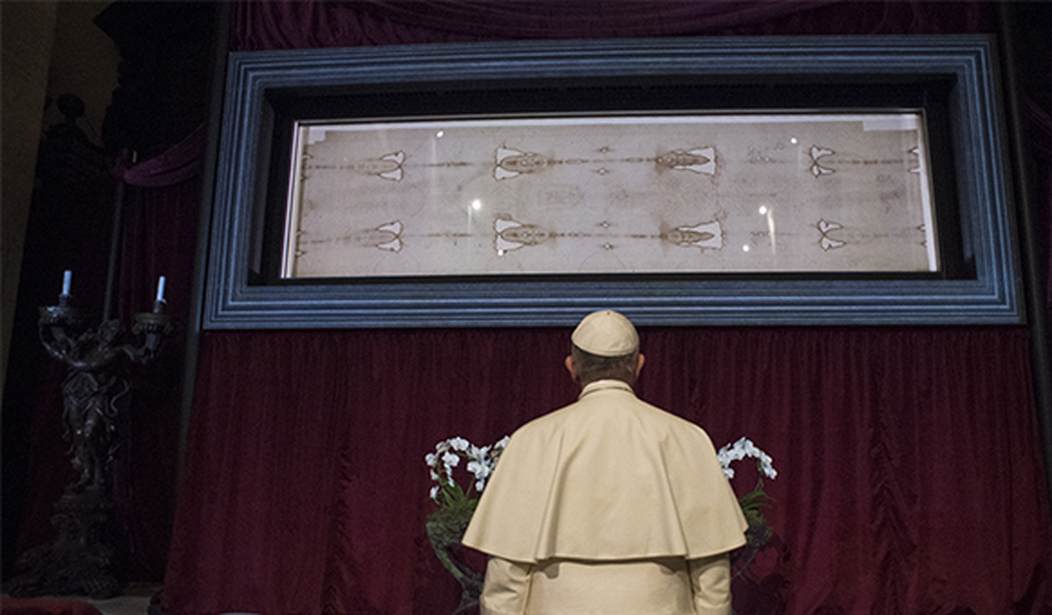In an imaginary “ranking” of Christian topics that elicit the most fervent discussions, Jesus Christ is No. 1. But near the top is the Shroud of Turin — believed by millions of Christians to be the authentic burial cloth of Jesus. This “ranking” was inspired by you — Townhall readers who wrote over 500 impassioned comments in response to my July 21 piece, “Shroud of Turin: New Test Concludes 1988 ‘Medieval Hoax’ Dating Was a Fraud.”
I purposely read all your comments to gain insight into my role as an adviser and fundraiser for a groundbreaking exhibition about the Shroud of Turin at the Museum of the Bible in Washington D.C. This spectacular museum, among the largest and highest rated in the city, is located only three blocks from the Capitol. And just prior to the January 20, 2021, presidential inauguration is when this high-tech Shroud exhibit is scheduled to open.
Threaded throughout hundreds of your responses about all aspects of the Shroud was one overarching theme summarized by these three comments:
“Anyone who requires physical evidence to underpin their faith doesn’t understand the concept of faith.”
“JESUS CHRIST died for all. HE is what is important. Making such a fuss about this piece of cloth is a distraction from HIS work of SALVATION.”
“I respectfully submit that the only ‘relic’ which really matters is the one which was left us on that first Easter morning: The tomb is empty! He is Risen! He is Risen indeed! Alleluia!”
Of course, “He is Risen” is also the foundation of my Christian faith, (made slightly more complicated by having been born Jewish). But I feel compelled to discuss and explore the comment that reads in part, “…such a fuss about this piece of cloth...”
And my response is simple: The Shroud of Turin exists because HE exists. An answer that echoes what God said to Moses, “I Am Who I Am. Say this to the people of Israel: I Am has sent me to you” (Exodus 3:14).
Recommended
Thus, the existence of the Shroud of Turin raises two questions that I will attempt to address: First, what exactly is the Shroud? And second, a deeper dive into “Why does the cloth exist?”
The Shroud of Turin is a 14.5-by-3.5-foot linen cloth with a linear front to back mirror image of a crucified man. The Shroud has the distinction of being the most studied artifact in the world, yet the cloth’s numerous mysteries remained unexplained by modern science.
At this moment the Shroud lies in a fireproof box in the Cathedral of St. John the Baptist in Turin, Italy, as it has continuously since 1578. (But secretly relocated between 1939 and 1946 when Italian authorities feared Hitler was seeking possession.)
Dating the Shroud has been controversial and the subject of my July 21 piece.
Among Shroud historians, there is no dispute that in 1352, over 200 years before the Shroud was housed in Turin, Geoffrey DeCharney displayed the cloth in Lirey, France marking the beginning of the Shroud’s documented "modern" dating.
There is also much circumstantial Shroud evidence through art, artifacts, and coins that pre-dates 1352. Moreover, scientifically verified botanical evidence found on the cloth in the form of pollen, dust, flowers, and even the weave and type of linen traces the Shroud back to first-century Jerusalem.
The cloth with its mysterious properties has survived wars, invasions and the ravages of time including numerous fires — most recently in 1997 at its home cathedral in Turin.
Most harrowing was the 1532 fire in Chambéry, France. Miraculously the entire cloth was not destroyed but left those distinctive linear markings along both sides of the Shroud that we see today. Hard to imagine, but the linen cloth was stored in a silver box, folded in 48 layers, when drops of molten silver burned through the cloth’s outer folded edges.
The point is, against all the odds, the Shroud exists. And, as stated earlier, because He exists. There is also a significant Bible-based reason found in the Gospel of John known as “Doubting Thomas” (John 20:24-31).
But first, a “guest” who will explain this passage needs a proper introduction:
It turns out that the many Townhall readers who commented about not needing the Shroud’s “physical evidence to underpin their faith,” represent a large swath of Christian believers. I learned this when asking Russ Breault— my fellow Shroud exhibit team colleague, and a world-renowned Shroud expert and speaker — if he had experienced similar attitudes after over 30 years of hosting his popular “Shroud Encounters” to sell-out crowds.
Breault replied:
“I get that statement all the time! When someone says, ‘I don't need the Shroud for my faith,’ I usually say, ‘That is fantastic! But that doesn't mean the Shroud was not meant for someone else.’ ”
Breault continued: “In the Doubting Thomas story, Jesus pronounced a blessing on those who ‘believe yet have not seen,’ but Jesus did not condemn Thomas for his unbelief. In fact, a week after the Resurrection, Jesus appeared a second time, and the first person he spoke to was Thomas, who was not there to witness Jesus’ first appearance. Jesus then quotes Thomas' words back to him, ‘Thomas, thrust your hand into my side and place your fingers into my nail wounds and be not faithless but believe.’
At this point, Thomas — forever known as "Doubting Thomas" — makes the strongest profession of faith in the New Testament saying, "My Lord and my God." Then Jesus pronounced a blessing on those who can believe without seeing. So we are blessed if we can believe without seeing, but we are not cursed if we can't get there without some additional evidence.
Therefore, perhaps the Shroud is a silent witness to the world offering all of humanity the same opportunity Jesus gave to Thomas. In some proverbial sense by looking at the Shroud, we too can thrust our hand into His side and place our fingers into His nail wound and find our faith in the process.”
Thank you, Russ! And now my final thoughts for Townhall commenters.
If blessed with great faith, you are free to ignore or downplay the image on the Shroud showing Christ’s great suffering and victory over death. Yet, take comfort in knowing that the Shroud is there to supplement or reinforce the faith of others while potentially witnessing to the ever-increasing number of Doubting Thomases found throughout the world.
In the end, I believe that the Shroud exists as proof of God’s greatest gift to mankind —the Lord Jesus Christ — who lives and reigns forever and ever. Alleluia!
(Now, let the comments begin!)

























Join the conversation as a VIP Member